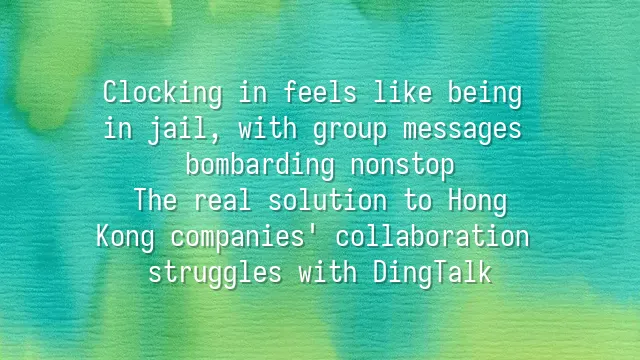
When Speed and Efficiency Meet Full Control
The core challenge of using DingTalk for collaboration in Hong Kong companies lies in a mismatch of management philosophies. Local businesses value "fast, neat, accurate" — speed, precision, and efficiency — but this does not equate to being held hostage by instant replies. Features like mandatory check-ins, read receipts, and DING alerts are often seen as digital surveillance tools by HR, triggering employee resistance. One financial institution introduced a “24-hour response benchmark,” only to see frontline staff switch en masse to private messaging apps, making project progress even less transparent — a classic case of misdirected solutions. Practical strategies don’t depend on powerful features, but on knowing how to limit access: disabling notifications after work hours, creating “do-not-disturb” work groups, and replacing “read receipt pressure” with “handle later” options. Some companies adopt a “one system, two practices” model — using DingTalk exclusively for liaising with mainland clients while relying on lighter platforms for internal communication. This maintains cross-border connectivity while protecting team members’ psychological space. Such strategic separation is an emerging digital bridge across cultural divides.
Language Gaps Trigger Communication Disasters
The collaboration challenges Hong Kong companies face on DingTalk often begin with linguistic pitfalls. The system automatically converts simplified Chinese to traditional, appearing user-friendly at first glance but frequently generating absurd results: “issuing a task” becomes “hair-cutting task,” sounding like monastic ordination; “creating a group chat” turns into “dragging a group,” evoking images of unlawful detention. These aren't mere translation errors — they're red flags signaling contextual breakdowns. Local white-collar workers are accustomed to thinking in Cantonese mixed with English jargon, and phrases like “pinning a post” or “DING someone” feel like cryptic puzzles. In contrast, platforms like Slack or Teams support multilingual interface switching and personalized language settings, better accommodating international teams. The breakthrough lies in proactive adaptation: some Hong Kong firms developed plug-ins that instantly translate “submit for approval” into “hand in form,” or display “follow up” as “chase payment,” paired with short training videos titled “DingTalk Slang Dictionary.” Within two weeks, operational accuracy improved by over 40%. The solution isn't demanding employees adapt to the system, but enabling the system to adapt to local context. Language is not just a tool for communication — it's a critical bridge between power and understanding.
Feature Overload Leads to Collective Paralysis
Another trap in Hong Kong’s DingTalk collaboration struggles is “feature obesity.” A simple clock-in process requires navigating three menu layers; starting a meeting demands activating five different plugins — complexity quickly becomes overwhelming. Observations show most Hong Kong teams end up using only chat and file-sharing functions, leaving advanced modules unused, effectively downgrading an intelligent platform into an electronic fax machine. The problem isn’t insufficient functionality, but excessive accumulation. DingTalk’s “do-it-all” design logic clashes fundamentally with Hong Kong companies’ need for flexible, efficient workflows. When submitting a sales quote requires jumping through seven modules, human nature defaults to email plus WhatsApp. Real solutions lie in simplification: bundling essential business processes — such as client quotations, inter-departmental reviews, and financial approvals — into “one-click workflow packages,” disabling redundant notifications, and customizing dashboard interfaces by job level. Management must abandon the myth of “full feature adoption”; rather than rolling out everything and having no one use it, precisely configure fewer, stronger modules so tools truly integrate into daily rhythms.
Building Intuitive, Localized Workflows
To solve Hong Kong companies’ DingTalk collaboration issues, workflows must be designed with people first. Common pain points include chaotic group naming — such as “Project Progress - Temporary Group - V2-final-Modified” — where information drowns instantly. Practical fixes involve adopting concise naming standards, like “Department_Project_Phase_Date,” which immediately boosts searchability. Going further, localized bot commands can help: typing “/meeting 3pm Client Briefing” automatically creates a meeting link and syncs it to Google Calendar, with reminders set in one click. Such micro-automations reduce communication friction and make cross-departmental processes replicable: when the marketing team submits an event report, a bot can automatically trigger the finance department’s reimbursement process, shifting execution from passive tracking to active progression. The best workflow is one you don’t notice. Leveraging features like Cantonese voice-to-text, quick-reply shortcuts, and localized automation turns regional differences into efficiency advantages — that’s true local wisdom.
The Psychological Shift: From Resistance to Enthusiasm
When DingTalk collaboration issues in Hong Kong companies evolve from IT jokes into universal complaints like “clocking in feels like stealing,” the problem has clearly taken root. Employees see DingTalk as surveillance; managers view it as the holy grail of productivity — this perception gap is more damaging than any delayed reply. Solutions cannot rely solely on new features, but must address behavioral motivation. One Hong Kong design firm introduced gamification: completing cross-department tasks unlocks virtual trophies, and top earners get lunch sponsored by the boss. Staff began eagerly marking tasks as complete — even proactively optimizing workflows. They also held a “Who Masters the Workflow” competition, allowing frontline employees to redesign approval paths, with winning proposals embedded as standard templates. Simultaneously, they launched an “IT Buddy” program, pairing younger staff with senior colleagues to teach practical skills like voice search and quick replies, reducing burdens and fostering intergenerational communication. Belonging can come from a perfectly timed meme reply in a group chat. When tools gain warmth, solutions naturally emerge — features once disliked become inside jokes and team signals. Transformation doesn’t have to be top-down; a single funny bot response might spark change.
We dedicated to serving clients with professional DingTalk solutions. If you'd like to learn more about DingTalk platform applications, feel free to contact our online customer service or email at

 English
English
 اللغة العربية
اللغة العربية  Bahasa Indonesia
Bahasa Indonesia  Bahasa Melayu
Bahasa Melayu  ภาษาไทย
ภาษาไทย  Tiếng Việt
Tiếng Việt  简体中文
简体中文